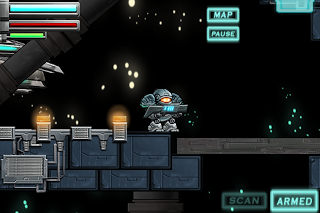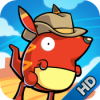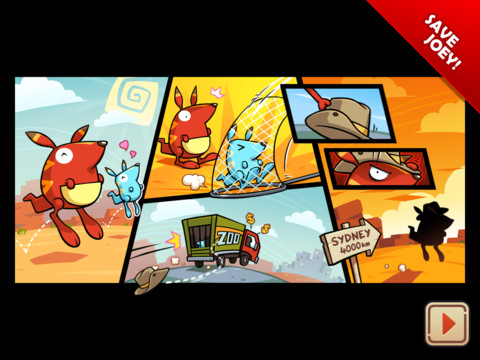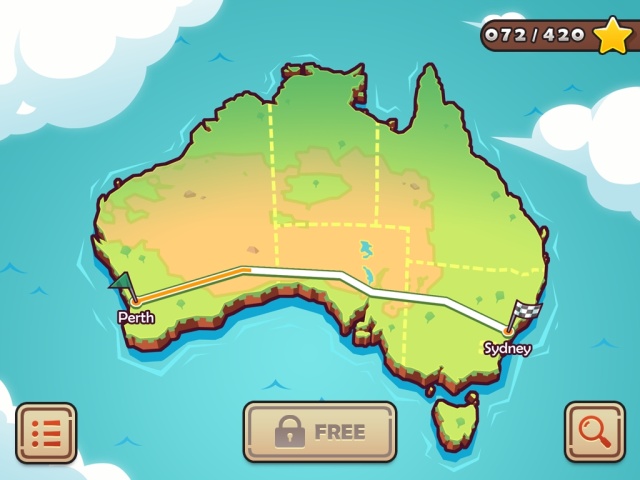Grinsia (Kemco) – $8.99
Number of Results: 175
This Friday post comes with good news! Secret Base’s iOS debut title, Tobe & Friends Hookshot Escape is officially launching on March 1st. I have not yet played the original Tobe computer games (Vertical Adventure, Hookshot Escape…), but I believe the gameplay is just about the same. After playing through Hookshot Escape, I must say that I am blown away by how well the controls work and also by the gorgeous yet simplistic artistic design.
We will have a full review on release day, but I’ll spoil some things for you to get you by. First thing you need to know is that there are a ton of unlockables. A ton. This game will keep you busy for a long time. Second, this game is HARD. You might think otherwise when you get your hands on Hookshot Escape, but in my mind this game is downright difficult. But keep in mind that every fall and every mis-step keeps you coming back for more. So far, Tobe & Friends Hookshot Escape feels like the perfect blend of hardcore platforming/hookshotting and a good time. That’s all I’m going to say for now. Check out the trailer and screens and mark March 1st on your calendars!

 Let’s hope Derek gets on it!***
Let’s hope Derek gets on it!***
Polarbit and Pixelbite are back with the sequel to one of the greatest racing games of all time. Back when the first Reckless Racing burst onto the App Store, we all fell in the love with the ease and beauty of drifting around corners. Although the sequel loses some of its power sliding glory, it more than makes up for it in every other aspect.
Content 5/5
This is where Reckless Racing 2 shines. For one thing, you will never get bored of playing this game. There are 4 game modes available, including Career, Arcade, Single Event, and Multiplayer. As compete in races, you earn money to spend at the shop. Apart from the variety of game modes, the shop is outstanding. There are more cars than you could ever fit in someone’s garage, and the upgrade system goes deeper than any other racing game on the App Store. On top of that, for small cost you can switch up your style by repainting your car, tinting the windshield, and even changing your rims.
Gameplay 3/5
Gameplay in RR2 varies somewhat with each game mode, but for the most part it feels the same throughout. The basic gist is that you race laps around these crazy courses that are full of obstacles and try to finish in first place. In Career mode, you compete in various Cups (ie. Reckless Cup, Roadrunner Cup) that consist of 3-6 events each. In total, there are 12 cups which makes for around 50 races in one career. Races come in three types; Race, Hot Lap, and Eliminator. Although there is nothing groundbreaking here, the different race types help to bring some replay value to the game. In Arcade mode, you compete is various single event challenges. Single Event mode is sort of a practice mode where you can choose one of the 3 race types and try to get your best times. The real key stone in the game is the Multiplayer mode. The way Multiplayer works is you hop into a lobby and you choose to either host your own room or join someone else’s. You can easily compete with your friends or with anyone in the world who is playing Reckless Racing 2. Multiplayer is available for all of the game modes, so go wild with the competition in whatever form you like.
Controls 3/5
If you’ve played the original Reckless Racing, you are familiar with the ease at which you could power slide around corners. My favorite control scheme in the original had to be the full wheel because it gave me the most control over the car. However, in RR2 things feel a bit different. On the bright side, there are 5 different control schemes to choose from, ranging from on-screen buttons, to steering wheels, to plain tilt. The way that the controls can be customized to your comfort is great, and this aspect helps you enjoy the game in its full glory. Unfortunately, despite the custimazability, for me some of the control schemes just didn’t work as expected. My biggest disappointment has to be that the full wheel isn’t what it used to be. For the most part, the wheel options were just too twitchy for me and it was difficult to travel in a straight line. Despite that fact, the on-screen button option works perfectly and I haven’t seen the need to use any other set-up.
Overall 4/5
Reckless Racing 2 is everything you could ask for in a sequel, plus some. Despite its setbacks, it’s nearly impossible to not enjoy your time on the track. Gorgeous visuals, easy to use controls, and tons of content make this the best racing game on the App Store. Race your way to the top (cliche right?) of the leaderboards and build up your dream car collection. At the premium price of $4.99 I heartily recommend Reckless Racing 2.

Run Roo Run
is a charming little game by 5th Cell (developers of Scribblenauts)
that sets the short story of a loving kangaroo mother attempting to get her
joey back (even though it looks like a loving couple). Roo’s poor joey has been
kidnapped and shipped off to Sydney, and it’s your job to trek across Australia
to save the poor joey. The game uses a basic one-touch control to make Roo jump
on, off, and over obstacles to reach his goal.



